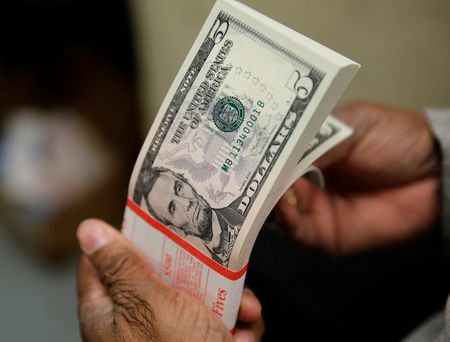By Hari Kishan
BENGALURU (Reuters) – The dollar’s recent comeback may not be indicative of a new broad trend, with FX strategists in a Reuters poll split on the greenback’s path in the next few months, suggesting volatility will dominate currency markets in the short run.
Having fallen about 1.5% in January the dollar clawed back all those losses after an eye-popping U.S. non-farm payrolls number on Friday raised doubts over market expectations the Federal Reserve would loosen monetary policy by end 2023.
Citing those unexpectedly strong jobs gains in January, Atlanta Federal Reserve Bank President Raphael Bostic said on Monday the central bank may need to lift borrowing costs higher than previously anticipated.
Interest rate futures pricing show markets are expecting the fed funds rate to peak just above 5.1% by July, roughly where the Fed sees it, compared with expectations of less than 5% prior to Friday’s jobs report.
That repricing is likely to keep volatility elevated in the near term. The J.P. Morgan VXY G7 Index is already above its 10-year average.
“I think the market’s going to be quite fickle and this whole process of the market’s view coming in line with the Fed’s view won’t be overnight…this is a process, and I do think we’re going to see some volatility,” said Jane Foley, head of FX strategy at Rabobank.
There was no clear majority among analysts who answered an additional question on what the greater risk was to the dollar over the coming three months.
While 12 said it was that the greenback declines at a faster speed, 11 said it would decline at a slower speed. The remaining 19 said the dollar rising was the greater risk.
“In the shorter run there’s some chance for the dollar to gain a bit…especially if the data stays relatively good and the Fed gets in at least two more hikes and there is some upside risk to the terminal rate for the Fed,” said Brian Rose, senior economist at UBS Global Wealth Management.
However, the consensus view in the Feb. 2-7 poll of 66 forex strategists predicted the dollar to weaken over the next 12 months.
The euro up 1.5% against the dollar last month, its best start to the year since 2018, has since given up all of those gains.
However, the common currency was forecast to strengthen from its current level to trade around $1.08, $1.09 and $1.11 in the next three, six and 12 months. That year-end prediction is around 3.5% higher from the $1.07 it was trading on Tuesday.
The Japanese yen down over 12% last year, its worst performance in nine years, was expected to change hands around 124/dollar in a year. If realised, that would be a gain of around 6.5% against the dollar.
Median forecasts also showed the British pound strengthening from $1.20 to $1.24 in the next 12 months.
But much still depends on the outlook for the dollar.
“We continue to expect the dollar to weaken – a number of factors sort of underpin that view. We do think the U.S. economy is likely to continue to slow but the most recent data we got on Friday certainly push us back against that hypothesis,” said Brian Daingerfield, head of G10 currency strategy at NatWest Markets.
“We also think inflation pressure is likely to continue to moderate as we go through the year and so we’re seeing less upside risk to the fed funds rate or the path of the fed funds rate as an upside risk to the dollar.”
(For other stories from the February Reuters foreign exchange poll:)
(Reporting by Hari Kishan; Analysis by Sarupya Ganguly; Polling by Prerana Bhat and Susobhan Sarkar; Editing by Bernadette Baum)

